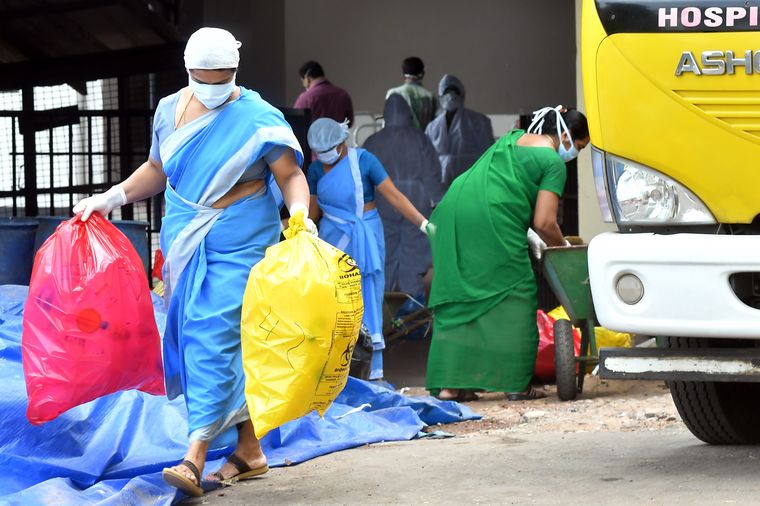Last September, health ministers from G20 nations, including India, met in Rome to discuss pandemic threats from nature. Biological Weapons Convention experts, meanwhile, gathered in Geneva, deliberating on rising threats from terrorists misusing microbes. Around the same time, Kerala was hit by a Nipah virus outbreak, the third such instance since 2018. Such biological threats, both natural and man-made, have become more frequent and complex.
The Covid-19 pandemic has taught us that it is ideal to prevent biothreats and control them early, before they explode catastrophically. Building further on the lessons learnt, India needs to assess the dynamics of existing biothreats and enhance the preparedness for averting them and managing them better.
Although pandemics originating from nature are generally taken as inevitable, it is human activity which is altering the natural history of infectious diseases and biothreats. Almost three-fourths of Emerging Infectious Diseases or newer infectious diseases are zoonotic, that is, coming from animals. Science has proven that fragmentation of wildlife habitat is birthing natural biothreats by bringing populations and livestock into closer and more frequent contact with wildlife. The geo-climatic and socioeconomic conditions make India particularly prone to zoonotic diseases. Two other natural biothreats to India are the increasing resistance of microbes to available antimicrobials and insect-borne diseases like dengue fever.
The man-made biothreats—accidental or intentional—have grown manifold in the last two decades because of the dazzling developments in biotechnology and microbiology. The number of laboratories and people handling the dangerous microbes has surged, raising the risk of misuse. Also, it has become more challenging to securely manage the genetic and other important information of the microbes. The worrying aspect is that knowledge in biosciences is developing faster than society is learning ways to keep it from misuse.
Accidental biothreats arise from human errors, resulting in unintended pathogen release from laboratories, hospitals or biowaste disposal. This happens because of inadequate training, poor understanding or negligence of the handling personnel, and improper facilities, procedures or protocols adopted in handling microbes. Intentional biothreats, on the other hand, originate from enemy states or people, when they misuse microbes for warfare, terrorism or in crimes.
India’s vulnerability to accidental biothreats is like that of any other country, whereas intentional biothreats cause country-specific concerns. The porous borders and the prevailing external and internal security scenarios raise the range and degree of intentional biothreats. There have been reports in the western media that terrorist groups like Al Qaeda and Islamic State are attempting to develop bioweapons. That underscores the urgency for India to muster robust means to counter biothreats.
Three misunderstandings about biothreats constrain our efforts to counter them efficiently. First, biothreats are often viewed as a human health sector responsibility, ignoring the relevance of other key sectors like animal health, environment, defence and security and disaster management, which are needed for tackling them. This not only discourages other sectors from owning up responsibility, but also deprives them of commensurate financial allocations.
Second, biothreats are perceived mainly from their consequences angle; the preventive and preparedness angles are missed. This is because their consequences are obvious, while the underlying causes are often obscure. Our approach, therefore, remains reactive rather than proactive.
Finally, our outlook towards natural, accidental and intentional biothreats is mostly causally segmented, whereas despite disparate contributing causes, they all have identical consequences, and it is not always possible to pinpoint their origins once they strike. Moreover, biothreats, irrespective of their causes, have common early detection and response, and even several functionalities involved in their prevention overlap and complement. Biothreats, therefore, call for a comprehensive and proactive outlook.
One Health—the interconnectedness of the health of people, animals and environment—is acclaimed internationally as the best approach to address natural biothreats. The UN bodies like WHO, OiE (World Organisation for Animal Health) and FAO (Food and Agricultural Organisation) have consistently endorsed the adoption of One Health. This concept has become all the more significant because of the rapid changes in interaction between people, animals and the environment. The coordination and collaboration between human health, animal health and environmental sectors have gained urgency in the wake of recurring pandemics.
Also read
Thailand has been one of the biggest beneficiaries of the initiative. Like most other southeast Asian nations, Thailand harbours several species of bats carrying the Nipah virus. These bats shed the virus seasonally, through their sputum and excreta. Humans can get infected when they come in direct contact with excreta or through contaminated food. The virus from bats can infect even domestic animals like pigs, from whom it can spread to human beings. By embracing a proactive and team-based approach along these multidimensional routes of infection, Thailand has stayed ahead of Nipah virus outbreak.
A scientific study published in the One Health Outlook journal by Supaporn Wacharapluesadee of Chulalongkorn University, Bangkok, elaborates how integrated teams comprising personnel from human health, veterinary and wildlife sectors in Thailand work together under the banner of One Health to prevent Nipah virus outbreaks. Wildlife personnel collect and test random bat excreta for the presence of the virus. This annual exercise happens during predetermined seasons when bats shed the virus. A few bats are captured for Nipah tests on their sputum and blood serum. Modern tools like machine learning are used for earmarking bat habitats, and GPS for tracking the bats' flight routes. This helps in identifying regions prone to contamination.
In these focused regions, veterinary experts test blood serum and nasal swab samples randomly from pigs for the Nipah virus every year, during seasons corresponding with virus shedding. They also advise pig farmers on precautionary measures. Similarly, personnel from the human health sector test serum and oral swab samples randomly for the virus from volunteer residents, including pig farmers. All the symptomatic cases from these areas are also tested for the virus. The medical personnel also make residents aware of risky behaviour that predisposes them to infection and train them on vigilance measures for early detection. The comprehensive screening of likely viral routes thus keeps the virus under close watch, which also helps in prevention and early intervention.
Thailand thought of adopting One Health after facing a severe setback in the bird flu pandemic in 2005. A committee headed by the country's deputy prime minister then decided that the complexity of emerging infectious diseases involving many factors could not be resolved independently. They undertook two National Strategic Plans between 2005 and 2010 to counter bird flu, with the collaboration of the ministries of public health, agriculture, natural resources and environment, and science and technology.
The 2009 swine flu pandemic drove Thailand further towards One Health. The country expanded the second National Strategic Plan beyond bird flu to include all types of emerging infectious diseases. It took help from international institutions for capacity building and established the One Health Network in 2011. With wide participation from key sectors and public involvement, the country formulated an evidence-based, bottom-driven policy in 2011-12. On August 28, 2012, the Thai cabinet adopted the National Strategic Plan on Emerging Infectious Diseases, fructifying a One Health success story.
In India, One Health has so far existed largely in discourses. Only a few instances, like the bird flu outbreak and the Covid-19 pandemic, saw some episodic convergence across human health, animal health and environmental sectors. Otherwise, the three sectors, at Central and state levels, exist with differing goals and power dynamics in their traditional designs. Their cumulative potential remains untapped in preventing natural biothreats. These sectors do not even have zoonotic diseases as a priority in their extant policies.
Certain positive developments which happened recently offer some hope. The NITI Aayog's white paper, “Vision 2035: Public Health Surveillance in India”, which was released in 2020, talks about integrating disease surveillance across human health, animal health and wildlife sectors. An announcement was made to establish a One Health Institute. The government has also launched a One Health Consortium, comprising 27 nationwide institutions from three sectors, working under the National Institute of Animal Biotechnology. Union Health Minister Mansukh Mandaviya wrote recently in an oped article that the Pradhan Mantri Ayushman Bharat Health Infrastructure Mission will finally “deliver the One Health approach” in India.
Accidental biothreats are best countered through biosafety—the measures taken to prevent microbes escaping from laboratories or other settings. India has elaborate biosafety regulations. The task of implementing the regulations is assigned to the ministries of science & technology and environment. However, the laboratories working on microbes are mainly run by the Indian Council of Medical Research and the Indian Council of Agricultural Research, which are under the ministry of health and the ministry of agriculture, respectively. Coordination, therefore, remains an issue. Also, the regulations are meant only for laboratories dealing with high-risk pathogens BSL (biosafety level)–3 and BSL-4 labs. These are not applicable to BSL-2 laboratories, which are aplenty in the country. These labs also need to be brought under the ambit of accreditation for basic minimum standards. The disposal of biowaste from laboratories and hospitals without disinfection, too, remains a hazard. Even indiscriminately used, genetically modified microbes in experiments or field applications can lead to accidental biothreats. These modified microbes interacting with environmental microflora can be dangerous.
The mechanism to address intentional biothreats exists in the Biological Weapons Convention, to which India is a signatory. And biosecurity is to intentional biothreats what biosafety is to accidental biothreats. The National Security Council addresses India’s security threats, and the Defence Research and Development Organisation under the ministry of defence helps counter biothreats. Besides, respective ministries coordinate their responses to intentional biothreats. But India still lacks a comprehensive biosecurity policy, although there are innumerable laws, like the Epidemic Diseases Act, the Livestock Importation Act, the Wildlife Protection Act, the Weapons of Mass Destruction Act and the Disaster Management Act for governing biosecurity. Some of these Acts are of the 19th century vintage. Most regulations under these Acts empower inadequately trained customs officials rather than subject-expert quarantine officials for screening incoming baggage. The public awareness on biosecurity matters, too, remains negligible.
For handling biological emergencies, the National Disaster Management Authority Guidelines of 2008 prevail. These guidelines also refer to replacing the Epidemic Diseases Act of 1897 with a comprehensive policy for biological disasters, which remains to be formulated. An attempt was made through a Public Health Bill in Parliament in 2017, but it got lapsed. Several states have now opted for their own legislation. In the past, too, legislative efforts to strengthen biosecurity have fizzled out. The Agriculture Biosecurity Bill, 2013, got lapsed.
India needs to revamp its entire mechanism of countering biothreats. A comprehensive and proactive approach is essential to confront biothreats successfully. At the apex level, a single entity dealing with all types of biothreats is the need of the hour. This entity should be assisted by a team of relevant organisations across different sectors. It should have pan-India, full-time responsibility, backed by related rules, bylaws and policy enforcement. It is crucial to have public involvement and participation through constant communication on desired practices. A trained workforce with appropriate knowledge and attitude holds the key to success. The preventive and preparedness operations need to be supported by effective data management, and research and development on complete continuum of biothreats, spanning from causative factors to testing to vaccination and recovery. Necessary resources must be allocated for capacity and capability building across sectors. Ensuring coordinated and efficient functioning of the apex entity across ministries and states will be of paramount importance.
The Covid-19 pandemic has exposed significant shortcomings in our approach towards threats from infectious diseases. It also provides potential avenues for India to alter relevant policies, institutional relationships and organisational frameworks. The country should focus holistically on biothreat prevention and early detection. Efforts and investment made in tracking potential pathogens in wildlife and in building biosecurity of livestock systems through One Health will surely prove productive in thwarting natural biothreats. The focused approach on deterrence similarly helps to keep accidental and intentional biothreats at bay.
The author is a microbiologist trained in biowarfare protection. narwalvet@gmail.com




